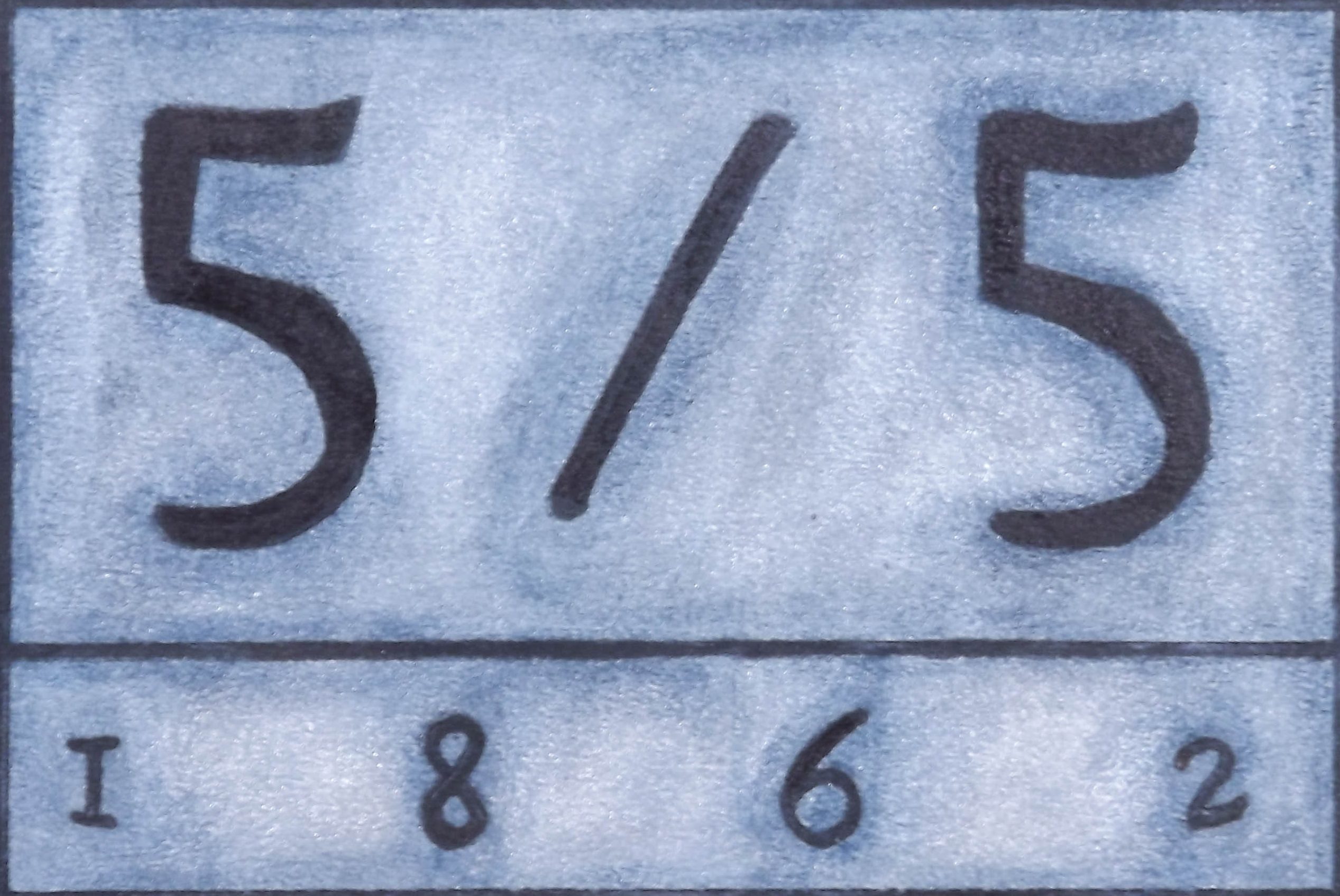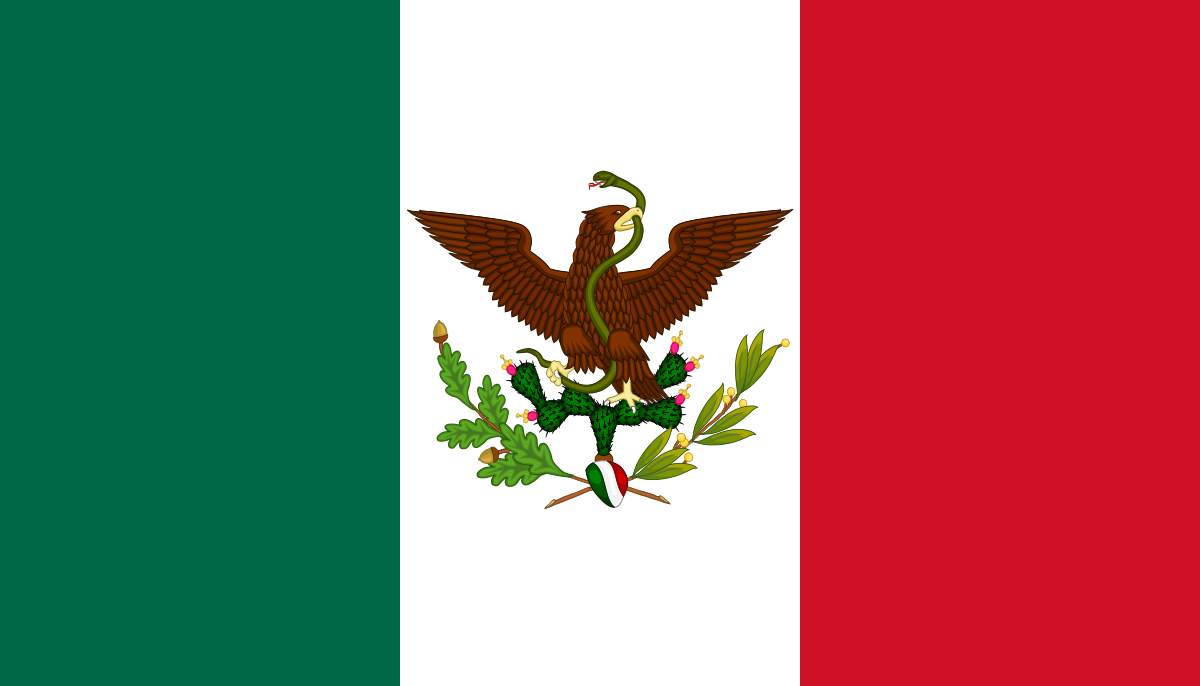The battle of Cinco de Mayo, took place between the Mexican Army and French forces near the city of Puebla,
Monday, May 5th 1862. Each May 5th, or “Cinco de Mayo”, in addition to commemorating Mexico’s victory
over the French, we remember the brave fight for freedom of a newly formed Mexico, which directly impacted
the outcome of the US Civil War. This is the reason why Cinco de Mayo is greatly celebrated in the United States,
as it reflects the historical and philosophical bonds that unite both nations.
A Brief History of Cinco de Mayo
After The War or Reform (1857 – 1861), Mexico was finally restored as one nation. However the war devastated the Mexican economy. Liberals who actually won the war, had contracted various loans with Spanish, British and French Banks.

President Benito Juarez, wanted to pay but had no way to satisfy these debts; consequently, Juarez had no option but to sign a memorandum in 1861 suspending all foreign debt obligations for two years. The British and Spanish negotiated; however, the French did not. Napoleon III, French Monarch between 1852 and 1870, and nephew of Napoleon Bonaparte, declared that diplomatic relations between both countries had erupted and decided to invade Mexico. The French landed in the Mexican port of Veracruz January 1962, and started a military advance into Mexico City.
Anticipating the French march into the Mexican Capital, Juarez ordered the fortification of the city of Puebla, 60 miles outside of Mexico City. This was strategic due to the fact that Puebla was surrounded by several stone forts. Most notably, the forts of Loreto and Guadalupe, which stood on hill tops. Mexican soldiers and volunteers fortified these forts by digging trenches and preparing them in order to prevent the French army from reaching Mexico City. As predicted the French army moved from Veracruz towards Mexico City and encountered heavy resistance in Puebla.
The Mexican troops fighting the resistance, were under the command of Texas born General Ignacio Zaragoza and General Porfirio Díaz. However, Mexico’s chances looked very dim as they faced the world’s best army which had remained undefeated since Waterloo, nearly half a century before. Additionally, the French had the support of the Zouaves, an elite French military group of Algerian descent, victors of Crimea and Sevastopol (former Russian empire), of Magenta and Solferino (Italy). Feared all over Europe for their ferocity. Ferared or unfeared, the Mexican army was not going to give up without a fight, to say the very least.

The Mexican resistance that confronted the French was comprised of two thousand enlisted Mexican soldiers and nearly the same number of volunteers. They were against eight thousand well-dressed French soldiers armed with pistols, cabinets, bayonets, and cannons. Mexican troops were outnumbered, outgunned and its soldiers had little experience. In fact Mexican soldiers had rifles purchased from the British in 1825 that had last been used in Waterloo (1815). Who would have known that those same old rifles were going to be used, not by the British, but by the Mexican army, to once again defeat the French almost half a century later? In fact those Mexican soldiers with those old rifles were the lucky ones, some were armed with only machetes or even metal tipped wooden spears. It is said that about half of the Mexican soldiers did not even have shoes! (Francisco Ignacio Taibo II, Director of Fund of Economic Culture, Speech 159th Anniversary of the 5 de Mayo Battle, May 5th 2022, National Palace, Mexico City ). The courage of the Mexican troops was such that once they ran out of bullets they began to throw rocks. This surely was a matter of dignity for Mexico. Deservingly so, Cinco de Mayo has become an unbreakable symbol of the tenacity, bravery and unity of the Mexican people.
«Our enemies are the first soldiers in the world, but you are the first sons of Mexico and they want to take away your homeland! Soldiers I see victory on your foreheads! … ¡Viva México!» General Ignacio Zaragoza, in his motivational speech before the Battle.
May 5th 1862 did not start well for the French. However things got even worse for the hostile invaders, when around 2 pm hard rain began to fall soaking the battle field and turning it into a slippery mud slide. This gave Mexican troops the advantage, since the French had to fight uphill in order to reach the previously mentioned forts of Loreto and Guadalupe.
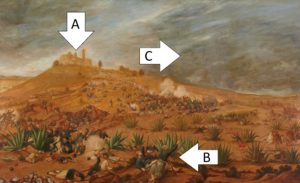 PATRICIO RAMOS ORTEGA
PATRICIO RAMOS ORTEGA
A – Loreto and Guadalupe.
B – Zuaves.
C – Storm.
Historians agree that another factor that put a weight in the balance in favor of the Mexican army was the arrogance of the invading forces. Days before the battle, General Lorencez, who commanded the Gallic army, wrote to the French Minister of War that they had «superiority of race, organization, discipline, morality and elevation of sentiment.» He requested that they inform the emperor, Napoleon III, that he considered himself already the «owner of Mexico.» Consequently, Lorencez supposed that it would be very easy for him to win and decided to attack prematurely. Tactical error that at the end of the day was very costly. Finally, when Napoleon III learned of the disastrous defeat of Lorencez, and under great pressure from French intellectuals, Lorencez was immediately replaced.
Aside from the tenacity of the Mexican army, the prompt torment and the arrogance of the french, another much less mentioned, but not less heroic factor was the decisive participation of the historically controversial General Porfirio Díaz. Who later held the presidency for 31 years. According to the National Institute of Historical Studies of the Revolutions of Mexico «the forces of General Díaz … rejected the French to the San José estate, forcing them to accept their defeat and withdraw towards Orizaba»
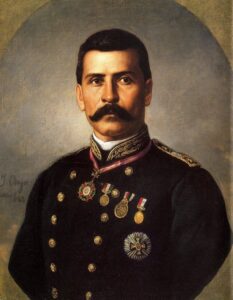
General Porfirio Díaz
In any case. The impossible was accomplished that rainy day, when a group of very brave Mexican soldiers and volunteers, lead by General Zaragoza and General Díaz were able to defeat the world’s greatest army. When fire ceased that memorable rainy afternoon, Zaragoza sent news of the victory in his famous report to President Juarez: “The national arms have been covered with glory». The impossible had been accomplished. Mexico had defended it’s territory victoriously.
Cinco de Mayo and The US Civil War
As previously mentioned, French, British and Spanish banks wanted to collect funds lent to Mexico, but only the French decided to invade in order to do so. Curiously enough, British and Spanish banks were owned way much more money than French banks did. In fact less than 4% of the total debt owned by Mexico to the three European nations was owed to the French. Due to this, historians believe that Napoleon III had the intention not only to collect, but also make Mexico a new French stronghold in the American continent. And just as importantly convert Mexico into a military platform of support for the Confederate Army during the American Civil War. Napoleon III wanted to take advantage of the instability in the United States during the Civil War, which prevented The Union from stopping the French advance into Mexico. The United States , due to its internal struggles, was not able to impose the Monroe Doctrine, which warned European powers not to interfere in the affairs of the Western Hemisphere (1823). Napoleon III wanted to prevent the Union from winning over the Confederate Army and evolving into a military and economic power that would possibly rival France.
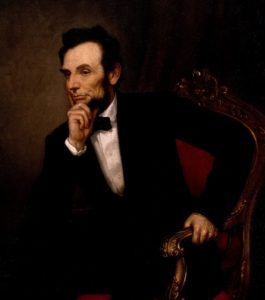
Mexico abolished slavery after declaring its independence from Spain in 1821, and has historically remained against any policy of racial discrimination. In fact President Juarez sent his foreign minister Mathias Romero to meet with US President Abraham Lincoln and offer him a message of support for the Union. Juarez clearly supported Lincoln’s values of liberty and democracy. Both presidents supported the idea of democratically elected government, and fought against reactionary forces, whether these were domestic or foreign. Juarez and Lincoln have been historically linked as good friends.
The Confederacy was eager not only for Napoleon III’s direct military assistance, but also to be recognized as an independent nation, which might have tipped the balance in their favor. As this by itself, could have implied military support. The Southern Army had high hopes of being recognized and this fact became a real possibility after a string of victories against the Union. As a consequence of this, recognition began to look increasingly likely. The Union was losing ground and was morally defeated; however the Mexican victory made the French pause for the Union army to suddenly grow stronger and gain momentum. Had Mexico not been victorious over the French, the outcome of the Civil War could have been different.
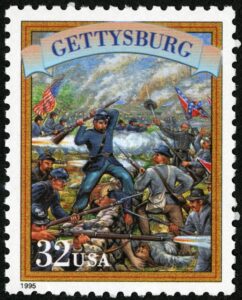
“The French would fail to accomplish the goal of conquering Mexico and turning it into a massive supply line for the Confederate States of America, and consequently destroy the Union. In 1862 that appeared to be a distinct possibility, Lincoln’s soldiers were defeated over and over in 1862 by Confederate soldiers at Bull Run, Maryland at Antietam Creek and a disastrous loss at Fredericksburg. Cinco de Mayo- had delayed the French Confederate plan to flood the south with everything they would need to win the war. By the time the French secured the border at the Rio Grande and started supplying the Confederacy, two major events occurred that buried Napoleon III’s plan: The battle for Vicksburg and the Battle of Gettysburg. The latter cost the Confederacy the war. Many posit the Confederate did not have enough cannons and cannonballs, they might have if the 4,000 Mexicans did not defeat the French Army on the 5th of May 1862”. (Cinco de Mayo, An American Holiday? Lowery Contreras Raoul).
One must keep in mind that in the 1860’s, the Southern States were predominantly agricultural based economies, relying deeply in the production of cotton by slaves. By contrast The Union had an enormous industrial advantage, and produced 3,200 firearms to every 100 produced by the Confederate States (Industry and Economy during the Civil War, Benjamin T. Arrington, www.nps.gov). Many Southerners still live a rural life… But, wars are won by harnessing industry’s power, giving the union a massive advantage. 4 out of 5 factories are in the north, making 25 times more weapons and 6 times more ammunition. (The Industrial Revolution. Manking: The History of All of Us. S1, E11, History Channel). Therefore, it was crucial for the Union to stop the Confederacy from getting their hands on weapons supplied by foreign nations, in this case France, in order to win the war. The victory of the Mexican army over French invaders in the Battle of Cinco de Mayo did exactly that.
Very sadly Mexico’s victory over the French in 1862 was short lived, and a year later they came back with 30 thousand men, who were able to invade Mexico and install Emperor Maximilian I. Nevertheless, the year long delay worked in favor of the Union. This bought enough time for the Union in order for them to win decisive battles and ultimately win the Civil War. After the French finally conquered Mexico in 1863, a year after the Cincode Mayo Battle, nothing Napoleon III could do could have saved the confederate army. He was a year too late.
When the Union was finally victorious over the Confederacy, Lincoln’s government became openly hostile to the French intervention in Mexico. Even several Union Army veterans began to make their way to Mexico to fight the invaders. Furthermore, after Lincoln’s assassination in 1865 President Johnson demanded the French withdraw from Mexico and imposed a naval blockade. Eventually the French left Mexico in 1867 leaving Maximilian behind, who was captured by Mexican forces and executed. US Army General Ulysses S. Grant, who later became the18th president of the United States (1869 to 1877) admitted passing arms to Mexican forces, stated “The Civil war was not over until the French were driven out of Mexico”
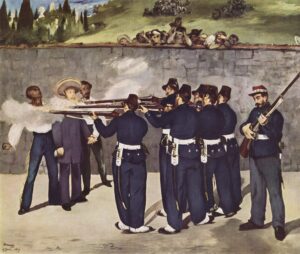
“The American Civil War and the French Intervention undeniably were closely linked. The French never would have intruded into Mexico had the United States not been distracted by the Civil War. Moreover, the eventual success or failure of the French Intervention in Mexico was tied to the outcome of the Civil War; if the Union won the United States could be expected to come to Juarez’ aid. Conversely, a successful bid for independence by the Confederacy would place a state friendly to the French directly ion Mexico’s northern border. In this context, the Union loss outside Richmond had greater importance to Latinos in Mexico and in the United States… The French recognition of the Confederacy might have tipped the balance of the Civil War in favor of the South. If the Confederacy were to become independent thanks to the French recognition and help, it was unlikely to object to the French attaining effective hegemony over Mexico. A reduced United States would be able to do little more than voice objections…” (David E. Hayes-Bautista, El Cinco de Mayo. An American Tradition).
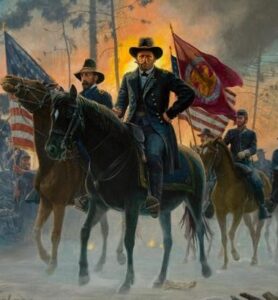
The Significance of Cinco de Mayo in the Latino Community Today
The Battle of Cinco de Mayo and its influential aftermath, offer a glimpse into the linked history between The United States and Mexico and their struggle for freedom, democracy and equality. No single event captures the bonds of friendship and history that tie Mexico and The United States together as does the battle of Cinco de Mayo. For this reason “Cinco de Mayo is an ideal day for the entire Hispanic and immigrant community to proudly remind everyone in the United States their importance of their contributions to the economic, cultural, and social fabric of this country” (Gerónimo Gutiérrez, Mexican Ambassador to the US, May 5th 2017).
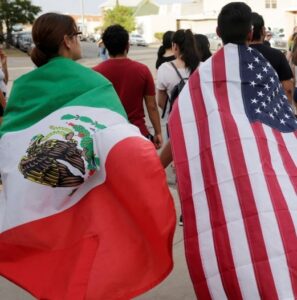
As of 2018, the Census Bureau, estimated that there were some 59.9 million Hispanics living in the United States (about 18% of the overall population).The second-largest racial or ethnic group behind whites. The projected Hispanic population of the United States for July 1, 2060 is 111 million people, or 30.2% of the nation’s total projected population. Furthermore, Latinos accounted for about half (52%) of all U.S. population growth between 2008 and 2018. The fastest growing ethnical group in the country. Hispanics, of Mexican origin, account for 63.3% of the nation’s Hispanic population. That is two out of three. According to a 2022 report by the Latino Donor Collaborative in collaboration with Wells Fargo, if Latinos In The United States were a country of its own, their gross domestic product would rank fifth in the world, surpassing those of the United Kingdom and France. Moreover, the two countries with the most Spanish speaking population are Mexico and the United States.
Mexican Americans have helped to make the commemoration of the Cinco de Mayo battle a cultural event, not only for them but also for the entire Latino community. For this reason. The White House officially began celebrating Cinco De Mayo in 2001, during the Presidency George W. Bush; and later under President Barack Obama. Traditionally, the White House invites dignitaries, politicians, artists and prominent figures in the Latino community to celebrate the contributions of Hispanics in the United States

The Battle of Cinco de Mayo is a reminder of the rights of liberty and justice that all habitants, at both sides of the Rio Grande, share and sometimes take for granted. Things could have been very different for all the inhabitants of The United States if those brave mexican men would not have defended their territory so heroically that rainy Monday afternoon, May 5th, 1862
¡VIVA CINCO DE MAYO! Y ¡VIVA MEXICO Y ESTADOS UNIDOS!
Francisco Díaz Cuéllar
